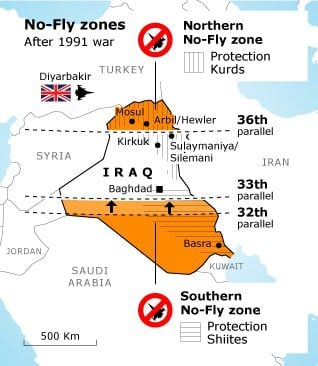In 1994, international support grows for Iraqi Kurdish groups, shaped by regional conflicts and complex geopolitical interests.

At least 200,000 rebels and civilians were slain in putting down the rebellions. Floods of Shiite Arab and Kurdish refugees converged on the borders of Saudi Arabia, Iran, and Turkey. Television pictures of exhausted Kurds in the freezing cold in the border region with Turkey – similar images of suffering Shiite Arab refugees on the border with Iran remained largely unseen – shocked international public opinion. The relation between the fate of these Kurds and the war in Kuwait was so clear that the anti-Iraq coalition could no longer look the other way. The Turkish government pressured Western governments to create conditions in northern Iraq that would enable the Kurdish refugees to return home from Turkey.
In mid-April the decision was made to set up a ‘Safe Haven’ in a small section of Iraqi Kurdistan, near Zakho and Dohuk, and a No-Fly Zone, north of the 36th parallel. (This was all done without any juridical basis in UN Security Council resolutions.) The zone covered only part of Iraqi Kurdistan, excluding, for instance, the city of Sulaymaniya. US, British, and (initially) French planes carried out daily reconnaissance flights over the area from Turkey’s Incirlik Air Force Base. The Iraqi army and its security forces and intelligence services were forced to withdraw from the Safe Haven. After several months, in October 1991, they unilaterally withdrew from most of the Kurdish region, realizing that they could not control the area without incurring major costs. To the great joy of the Kurds, this opened the way for a de facto free Kurdistan in Iraq.
In August 1992 a second No-Fly Zone was established, south of the 32nd parallel (extended north to the 33rd parallel in 1996). This offered the Shiite Arab population little protection, because, unlike in the north, the army and secret police remained active in the zone. The measure was intended primarily to protect the foreign troops stationed in Kuwait and Saudi Arabia from Iraqi air attack.
From then on there was a de facto Kurdish self-government, the Kurdistan Regional Government (KRG), in the three northern provinces of Dohuk, Arbil, and Sulaymaniya, as well as in parts of neighbouring provinces, inhabited mainly by Kurds. A general election was held on 19 May 1992. The result, a near stalemate between the two main parties, the Kurdistan Democratic Party (KDP) and the Patriotic Union of Kurdistan (PUK), created growing political tensions. In 1994 a bloody civil war broke out, which led to a de facto division of the area into a KDP-ruled zone and a PUK-ruled zone. Only after the downfall of the regime of Saddam Hussein in 2003 were the KDP and the PUK reconciled.


